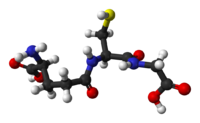
Latent turn-on fluorescent probe for the detection of toxic malononitrile in water and its practical applications.
Sign Up to like & getrecommendations! Published in 2020 at "Analytica chimica acta"
DOI: 10.1016/j.aca.2019.10.015
Abstract: A latent turn-on fluorescent probe for the detection of malononitrile (NCCH2CN), a precursor of hydrogen cyanide (HCN) in the mammalian tissue metabolism, is developed based on reaction-based fluorophore generation for the first time. Malononitrile is… read more here.
Keywords: turn fluorescent; probe detection; fluorescent probe; latent turn ... See more keywords

NCL-based mitochondrial-targeting fluorescent probe for the detection of Glutathione in living cells
Sign Up to like & getrecommendations! Published in 2021 at "Chinese Chemical Letters"
DOI: 10.1016/j.cclet.2021.06.033
Abstract: Abstract Glutathione (GSH) plays a critical role in maintaining cellular redox homeostasis in biological system. Mitochondrion is a pivotal organelle for cellular aerobic respiration and its disorder is associated with impaired redox balance, leading to… read more here.
Keywords: fluorescent probe; detection; probe detection; mitochondrial targeting ... See more keywords

A novel carbon dots derived from reduced L-glutathione as fluorescent probe for the detection of the L-/D-arginine
Sign Up to like & getrecommendations! Published in 2017 at "New Journal of Chemistry"
DOI: 10.1039/c7nj03320f
Abstract: In this report, water-soluble carbon dots (CDs) with stable fluorescence (FL) were designed and synthesized by using environment-friendly reduced L-glutathione (GSH) as the precursor and ethylenediamine (EDA) as the passivating agent through a one-step hydro-thermal… read more here.
Keywords: probe detection; reduced glutathione; detection; carbon dots ... See more keywords

Small-Molecule Fluorogenic Probe for the Detection of Hypochlorite and Its Application in the Bio-imaging of Human Breast Cancer Cells
Sign Up to like & getrecommendations! Published in 2023 at "Analytical Methods"
DOI: 10.1039/d3ay00646h
Abstract: A certain amount of hypochlorite can help to regulate the body’s defense system while excessive hypochlorite has some complex influence on health. Herein, a thiophene-derived biocompatible turn-on fluorescent probe (TPHZ)... read more here.
Keywords: small molecule; probe detection; detection hypochlorite; fluorogenic probe ... See more keywords

Fluorescence “turn-on” probe for the detection of HSO3- based on pyrene-functionalized mesoporous silica material
Sign Up to like & getrecommendations! Published in 2023 at "New Journal of Chemistry"
DOI: 10.1039/d3nj01095c
Abstract: The sensitive detection of bisulfite residues (HSO3-) is of great importance for ecosystems and public health. In order to overcome the problems of poor water dispersion stability and low sensitivity... read more here.
Keywords: probe detection; fluorescence turn; detection hso3; hso3 based ... See more keywords

An NBD-based Fluorescent Turn-on Probe for the Detection of Homocysteine over Cysteine and Its Imaging Applications
Sign Up to like & getrecommendations! Published in 2017 at "Chemistry Letters"
DOI: 10.1246/cl.161123
Abstract: An NBD-based fluorescent probe (probe 1) for the detection of Hcy over Cys and GSH based on nucleophilic substitution and Smiles rearrangement reaction was designed and synthesized by the reaction of 4-chloro-7-nitro-2,1,3-benzoxadiazole (NBD-Cl) with 1,4-dihydroxybenzene.… read more here.
Keywords: nbd based; detection; probe; probe detection ... See more keywords

Monodispersed Gold Nanoparticles as a Probe for the Detection of Hg2+ Ions in Water.
Sign Up to like & getrecommendations! Published in 2017 at "Acta chimica Slovenica"
DOI: 10.17344/acsi.2016.3054
Abstract: Gold nanoparticles were synthesized using Ananas comosus as reducing agent. UV-visible spectra show the surface plasmon resonance peak at 544 nm. TEM measurement shows that the formation of monodispersed spherical nanoparticles with average size of… read more here.
Keywords: gold nanoparticles; water; probe detection; gold ... See more keywords